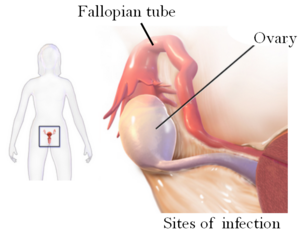Tubo-ovarian abscess
| Tubo-ovarian abscess(TOA) | |
|---|---|
 |
|
| Drawing showing the sites of Tubo-ovarian abscess | |
| Classification and external resources | |
| Specialty | urology |
| ICD-10 | N70 -N77 |
| ICD-9-CM | 614.2-616 |
| DiseasesDB | 9748 |
| MedlinePlus | 000888 |
| eMedicine | emerg/410 |
| MeSH | D000292 |
Tubo-ovarian abscesses (TOA) are one of the late complications of pelvic inflammatory disease (PID) and can be life-threatening if the abscess ruptures and results in sepsis. It consists of an encapsulated or confined 'pocket of pus' with defined boundaries that forms during an infection of a fallopian tube and ovary. These abscesses are found most commonly in reproductive age women and typically result from upper genital tract infection. It is an inflammatory mass involving the fallopian tube, ovary and, occasionally, other adjacent pelvic organs. A TOA can also develop as a complication of a hysterectomy.
Patients typically present with fever, elevated white blood cell count, lower abdominal-pelvic pain, and/or vaginal discharge. Fever and leukocytosis may be absent. TOAs are often polymicrobial with a high percentage of anaerobic bacteria. The cost of treatment is approximately $2,000 per patient, which equals about $1.5 billion annually. Though rare, TOA can occur without a preceding episode of PID or sexual activity.
The signs and symptoms of tubo-ovarian abscess (TOA) are the same as with pelvic inflammatory disease (PID) with the exception that the abscess can be found with magnetic resonance imaging (MRI), sonography and x-ray. It also differs from PID in that it can create symptoms of acute-onset pelvic pain. Typically this disease is found in sexually active women but sexually inexperienced, virginal girls have rarely been found with this infection.
The development of TOA is thought to begin with the pathogens spreading from the cervix to the endometrium, through the salpinx, into the peritoneal cavity and forming the tubo-ovarian abscess with (in some cases) pelvic peritonitis. TOA can develop from the lymphatic system with infection of the parametrium from an intrauterine device (IUD). Bacteria recovered from TOAs are Escherichia coli, Bacteroides fragilis, other Bacteroides species, , , and aerobic . Long term IUD use is associated with TOA. Actinomyces is also recovered from TOA.
...
Wikipedia
